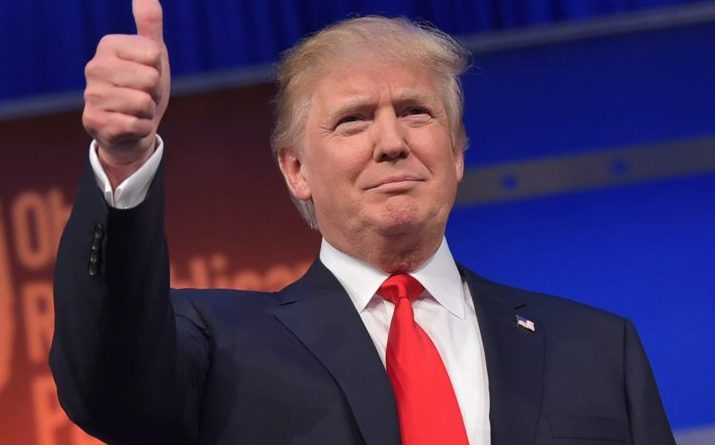Election 2016: What’s next for climate policy?
Photo by Transition 2017/CC by 4.0
Article by Hannah Klaus
On Tuesday, November 8th, Donald J. Trump was elected to be the next president of the United States winning enough states to garner 290 electoral votes (6). Throughout his campaign, Trump has promised to cut environmental regulations and has denied climate change multiple times. For example he tweeted, “The concept of global warming was created by and for the Chinese in order to make U.S. manufacturing noncompetitive.” (8). In the days after the election, and just a week after the Paris Climate Agreement entered into force, the future of national and international climate policy is uncertain.
During his campaign, Trump has said that upon his election he would “cancel” the Paris Climate agreement. It remains unclear how he would pull the U.S. out of the agreement. Now that the agreement has entered into force, any party cannot withdraw for three years, and this is after a one-year waiting period. If the U.S. does not act in accordance to the agreement, some nations will likely continue forward (7). However, the incentive for nations, developing nations in particular, to ramp up environmental regulations weakens if the world’s second largest greenhouse gas emitting nation fails to participate in this effort (2). However, if the U.S. backs out of the agreement under a Trump presidency, there will be disapproval from the international community, which could have negative implications for foreign relations on other issues. Additionally, without efforts to cut emissions and to invest in and develop clean energy, U.S. emissions have the potential to reserve their current trend, and begin to rise (2).
In terms of domestic climate policy, Trump has made it very clear that he intends to minimize environmental regulations and to abandon many of the Obama administration’s efforts to fight climate change. He promised to abolish the Environmental Protection Agency (EPA) during his campaign, and since his win he was appointed climate change skeptic Myron Ebell to lead the EPA transition team (3). Under Ebell’s lead, Trump intends to dismantle the Clean Power Plan, which would require U.S. power plants to reduce their emissions. The existing administration is set to defend the proposal before the Supreme Court, so there is a potential for Trump administration to abstain from defending the rule. However, it is unlikely that the Clean Power Plan will go down without a fight since many states, municipalities, and organizations actively support it (4).
As consequential as Trump’s victory is for international and national climate policy, many state level policies were decided as well. In Florida, Amendment 1, a utility backed proposal aimed a limit solar power expansion and giving power monopolies control over the accessibility of solar energy, was rejected by voters (5). In Washington State, voters also rejected a proposal for a carbon tax. The ballot measure received significant criticism from many environmental and social justice groups, including a coalition within the state, The Alliance for Jobs and Clean Energy, which is now working on revising the proposal to be more targeted towards environmental justice (1).
Effective climate action will not come from a fight but a battle. History shows that progress on any issue comes from many small steps that create an overall trend towards progress. Despite the potential for environmental setbacks during a Trump presidency, concerned and environmentally conscious citizens will stand for what is right.
- Berton, Hal. “Washington State Alliance to Push a Reworked Carbon-tax Proposal.” The Seattle Times. November 12, 2016. Accessed November 13, 2016. http://www.seattletimes.com/seattle-news/environment/washington-state-alliance-to-push-a-reworked-carbon-tax-initiative/.
- Davenport, Coral. “Donald Trump Could Put Climate Change on Course for ‘Danger Zone’.” The New York Times. November 10, 2016. Accessed November 13, 2016. http://www.nytimes.com/2016/11/11/us/politics/donald-trump-climate-change.html?_r=0.
- Fountain, Henry. “Trump’s Climate Contrarian: Myron Ebell Takes On the E.P.A.” The New York Times. November 11, 2016. Accessed November 13, 2016. http://www.nytimes.com/2016/11/12/science/myron-ebell-trump-epa.html.
- Harvey, Chelsea. “Trump Has Vowed to Kill the Clean Power Plan. Here’s How He Might — and Might Not — Succeed.” The Washington Post. November 11, 2016. Accessed November 13, 2016. https://www.washingtonpost.com/news/energy-environment/wp/2016/11/11/trump-has-vowed-to-kill-the-clean-power-plan-heres-how-he-might-and-might-not-succeed/.
- Klas, Mary Ellen. “Florida Voters Say No to Misleading Solar Amendment.” Miami Herald. November 13, 2016. Accessed November 13, 2016. http://www.miamiherald.com/news/politics-government/election/article113449438.html.
- “Presidential Election Results 2016 – Cnn.com.” CNN. Accessed November 13, 2016. http://www.cnn.com/election/results/president.
- “Status of Ratification.” The Paris Agreement. Accessed November 13, 2016. http://unfccc.int/paris_agreement/items/9485.php.
- Twitter. November 6, 2012. Accessed November 13, 2016. https://twitter.com/realdonaldtrump/status/265895292191248385?lang=en&lang=en.

